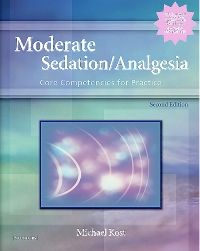This 2nd edition focuses on the preprocedural, procedural, and postprocedural care of the moderately sedated patient. It is designed for any clinician involved in the administration of moderate sedation and written by a clinician involved in the practice on a daily basis. The primary focus of this new edition is to provide all the content and tools necessary to demonstrate competency in moderate sedation/analgesia.
New to this edition
- Follows a recommended ‘core curriculum’ format, but each idea and concept are discussed in detail.
- Increased integration of actual Clinical Scenarios facilitates the application of content knowledge and utilization of critical thinking skills.
- Integration of herbal preparations and their impact on pre-sedation care.
- Latest JCAHO Sedation/Anesthesia Guidelines (2004) incorporated throughout.
- A larger trim size (8.5 x 11) provides more of a ‘manual’ feel and allows the reader to make notes and work through various tools throughout the book.
Key Features
- Includes a greater focus on the core competencies necessary for clinical practice.
- Concept Checks are integrated throughout to help the learner assess the mastering of the content presented.
- Includes the recommended standards of practice from the ANA, AORN, American Academy of Pediatrics, and JCAHO's Sample Policies & Procedures.
- Contains sample clinical competencies for moderate sedation so the book can be used as a study guide and measurement tool.
- Incorporates throughout important information on the specific moderate sedation parameters of the pediatric and geriatric patients addressing preprocedural assessment, physiologic variations, pharmacologic considerations and sedative techniques.
- Includes a comprehensive pharmacologic profile of each medication used in the moderate sedation practice setting.
Author Information
By Michael Kost, DNP, CRNA, CHSE, Director, Healthcare Simulation, Einstein Healthcare Network, Philadelphia, PA; Director, Frank J. Tornetta School of Anesthesia at Einstein Medical Center Montgomery, Norristown, PA and Associate Clinical Professor, La Salle University School of Nursing, Philadelphia, PA
UNIT ONE: Preprocedural Patient Care
1. Goals, Definitions, Practice Standards and Guidelines
2. Presedation Assessment and Patient Selection
UNIT TWO: Procedural Patient Care
3. Pharmacologic Concepts
4. Sedation/Analgesia Medication and Techniques of Administration
5. Sedation/Analgesia Pharmacologic Profile
6. Procedural Patient Monitoring
7. Airway Management and Management of Respiratory Complications
8. Intravenous Insertion Techniques/Intravenous Solutions
9. Geriatric Patient Care
10. Pediatric Patient Care
UNIT THREE: Postsedation Patient Care
11. Postsedation Patient Care, Monitoring, and Discharge Criteria
12. Risk Management Strategies
APPENDICES
A. Practice Guidelines for Sedation and Analgesia by Non-Anesthesiologists
B. Joint Commissions: Standards for Sedation and Anesthesia Care
C. Endorsement of Position Statement on the Role of the Regional Nurse (RN) in the Management of Patients Receiving IV Conscious Sedation for Short-Term Therapeutic, Diagnostic, or Surgical Procedures
D. American Academy of Pediatrics Committee on Drugs
E. Clinical Competencies for Sedation-Analgesia
F. American Association of Nurse Anesthetists
G. Learner Self-Assessment References














